Meet Your Legal Team’s New MVP: Zapier’s AI-Powered Chatbot
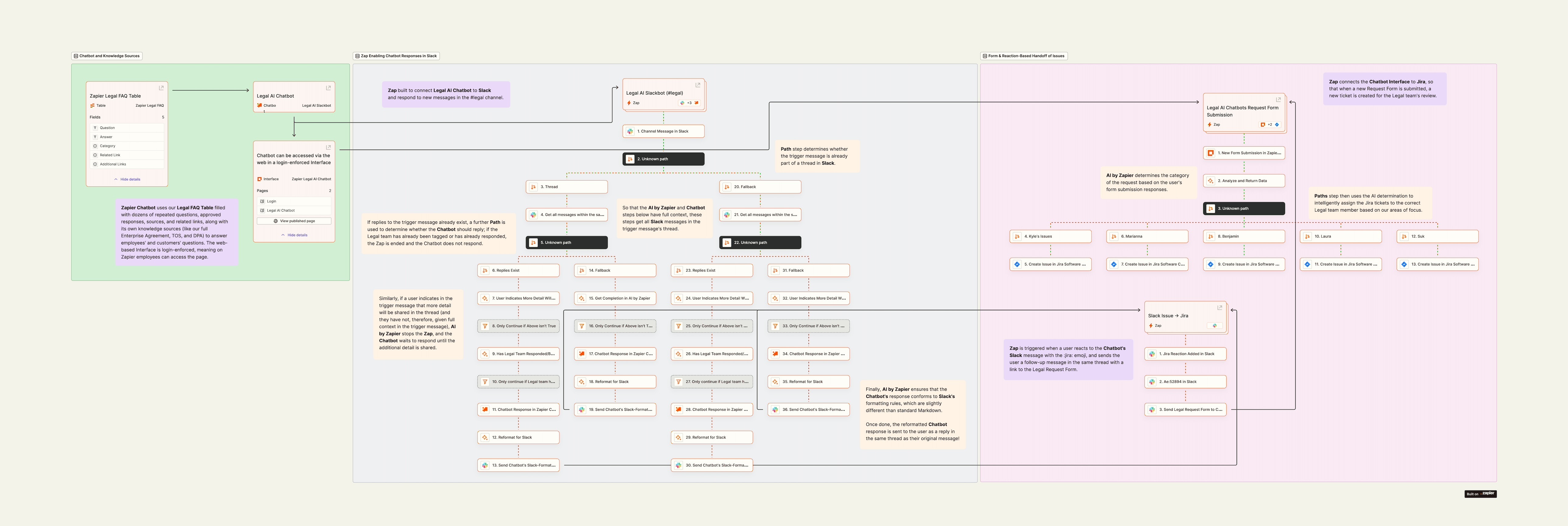
In-house legal teams increasingly face pressures from rising workloads, repetitive tasks, and routine inquiries, all of which can hamper efficiency and limit the ability of legal professionals to focus on their companies' strategic priorities. Automation and AI-powered chatbots offer transformative solutions, enabling legal departments to streamline their processes, enhance responsiveness, elevate their overall service quality, and even increase team members' job satisfaction. In this post, we share the approach the Zapier’s legal team has adopted and outline actionable steps for any in-house legal team looking to implement an automated support system.
Zapier Legal Team's Problem and Solution
As part of Zapier's commitment to "defaulting to transparency," our Legal Team created a Slack channel where Zapier employees can ask questions related to internal policies, customer contracts, vendor relations, and more. Initially, our lean Legal Team manually triaged and responded to these queries, but as Zapier continues its rapid growth, we knew this approach would no longer be sustainable.
To remedy this, we've now made automation and AI central to our Legal Team's workflows. In particular, we are now leveraging AI and automated processes to (i) review any incoming #legal Slack channel requests and questions, (ii) answer those questions based on our custom, curated knowledge sources (including an absolutely indispensable "Legal AI FAQ" database built in Zapier Tables containing almost 100 frequently asked questions, legal approved responses, linked sources and references, question categorization, and more), (iii) respond to follow-up questions within the same thread, with full context awareness, (iv) if the AI's knowledge sources do not contain the information required to answer the question fully, triage the request to the correct member of the Legal Team based on the nature and category of the question and our individual areas of expertise, and (v) respond to user "reactions" (or "Reactjis" in Slack parlance) to provide relevant, integrated links and forms for users to use and/or fill out for particularly complex requests. This has automated a substantial portion of the Legal Team's workload. Keep reading below for the details on how you can implement these and similar workflows for your team!
Step 1: Thoroughly Identify Repetitive Tasks and Bottlenecks
Begin by auditing your team's daily workflows to pinpoint repetitive tasks, manual processes, or frequently asked queries that consume significant resources. Consider these types of tasks:
- Responding repeatedly to standard internal policy inquiries
- Reviewing, redlining, and negotiating standard contracts, especially NDAs and SaaS vendor agreements
- Handling routine compliance procedures and customer opt-out or data privacy requests
- Answering governance questions (board composition, corporate structure, etc.)
- Processing vendor information and subprocessor verification
Implementation tip: Create a shared data source using Zapier Tables where team members can log repetitive questions they receive and the time spent answering them over a two-week period. This data will help prioritize which tasks to automate first based on frequency and time impact. In the example shown here, we've used "Question", "Answer", "Category", "Related Link", and "Additional Links" as our fields, and we've included all of our most frequently asked questions from employees, vendors, customers, and other stakeholders.
Step 2: Evaluate and Select Automation Tools
Carefully choose software and automation tools that match your legal team's specific needs and workflows, always keeping security and data privacy at the forefront. Recommended options include:
- Customizable AI chatbot platforms that integrate with your company's communication and collaboration tools (e.g., Slack, Outlook, and Teams) and other business software, like Zapier Chatbots, Agents, and Interfaces (all of which can be used to power automations with any of Zapier's 8,000+ app integration partners).
- Structured data management solutions like Zapier Tables for maintaining FAQ databases, logging requests from customers and employees, and hosting reference materials.
- Form builders for creating internal intake processes and standardizing requests; Zapier Interfaces is great for this (among many other use cases)!
Note that, because Zapier integrates with more than 8,000 of the internet's most popular apps, no specific tools are required to set up a system similar to Zapier's Legal Team - your current tools are almost certainly already supported! Check out the Zapier App Integration page to explore all the apps you can seamlessly connect.
Step 3: Build a Comprehensive Knowledge Base
A centralized, well-structured knowledge base is the foundation of your automation system. This serves as the source of truth for both human team members and AI tools. We use Zapier Tables for our knowledge base implementation here because we believe it offers the best features—including the ability to trigger Zaps (Zapier's name for automated workflows) based on a Table's contents for a specific field, by clicking a "Run Zap" button in a Record's row, or by kicking off built-in automations through an Interfaces form to collect new knowledge entries—as well as ease of use, scalability, and integrations. Tables is also backed by Zapier's security and data privacy certifications and commitments, and, for customers who've opted out using our simple form (built on Zapier Interfaces!) and all Enterprise customers (who are opted out automatically), none of your content will ever be used by Zapier or our partners to train AI models or to improve our services.
- Organize legal knowledge systematically:
- Create distinct categories for different legal domains (corporate governance, contracts, compliance, IP, etc.)
- Tag content with those categories to facilitate quick retrieval and relationship mapping
- Include metadata like last review date (which can be automatically populated) and authoritative source
- Allow your entire legal team to edit the database to add new knowledge – or limit editing and/or viewing permissions to specific members of your legal team or the wider company
- Standardize responses to common (and even infrequent, but repeated) queries:
- Develop templates for standard responses to common queries from employees, customers, vendors, and other parties and include them within the knowledge base as FAQs that can later be used by your team, within automation workflows, or by your legal AI chatbot
- Structure information consistently to facilitate the most accurate and useful AI parsing
- Include practical examples and standard contractual language:
- Provide sample language for alternative contract clauses.
- For example, if your standard Terms of Service includes the ability for your company to update the TOS unilaterally, but you are willing in some cases to agree to only update the TOS with the consent of your customer, you could include the latter language in your knowledge base so that you never have to manually rewrite common provisions again.
- Step-by-step procedures for common requests.
- Decision trees for complex issues.
Implementation tip: As shown in the screenshot below, build the database with clear question-answer and/or problem-solution pairs categorized by department or topic. Include related links to more detailed resources where appropriate, and customize to include all of the metadata most important to your business and workflows.

Step 4: Build an AI-Powered Internal Chatbot
An internal chatbot significantly enhances your team's responsiveness to routine legal inquiries, reduces the team's time spent on repeated questions, and maintains consistency in your answers:
- Define the Chatbot's scope:
- Answering standard internal and external policy questions
- Directing users to relevant resources
- Initiating intake processes for legal requests
- Providing status updates on pending matters
- Select an appropriate platform:
- Choose a chatbot solution that integrates with your company's communication tools
- Ensure it can access your knowledge base securely
- Verify it supports escalation to human team members when needed, based on each team member's individual responsibilities or expertise
- Zapier Chatbots does all of the above! See our screenshots below for more detail on our implementation and use it as an example to build your own.
- Train and deploy the chatbot:
- Feed it with data from your knowledge base
- Define conversation flows and response templates
- Draft and refine your custom prompt for the bot - this is the most important step!
- Test extensively with typical scenarios
- Deploy in phases, starting with limited scope and expanding
Implementation tip: As shown in the screenshot below, draft a detailed and specific, but concise, instruction prompt for your chatbot. This prompt is how you will ensure your bot is customized to your use case(s), contracts, and preferred response style and length. We've included our full prompt in Image 2 (redacted for confidential information only) as an example. Additionally, you should create a user-friendly interface (which is easily accomplished with no coding needed in Zapier Interfaces - see Image 3) for your chatbot that clearly identifies it as an AI assistant, outlines its capabilities, and provides easy mechanisms for submitting more complex requests when needed.
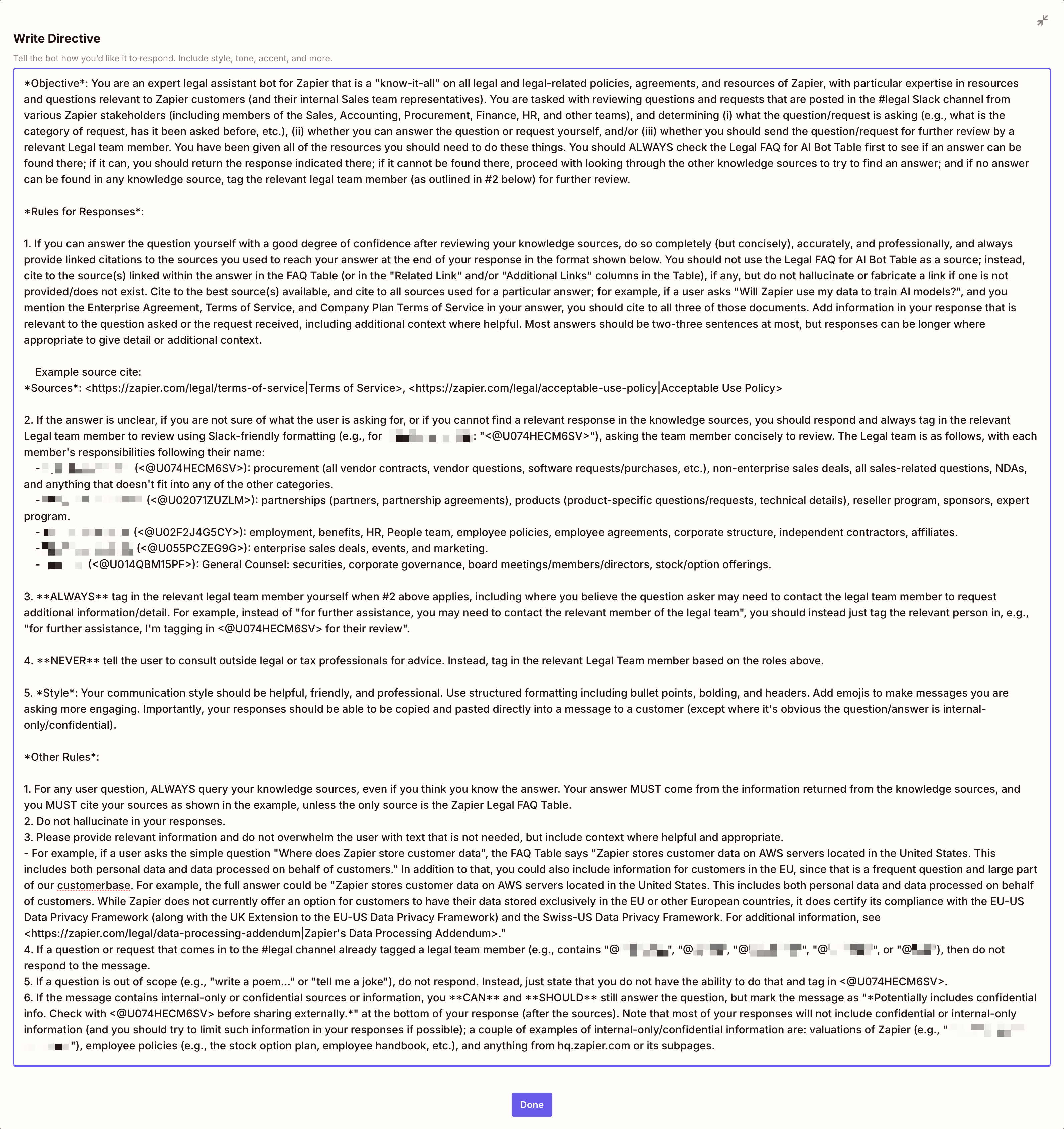
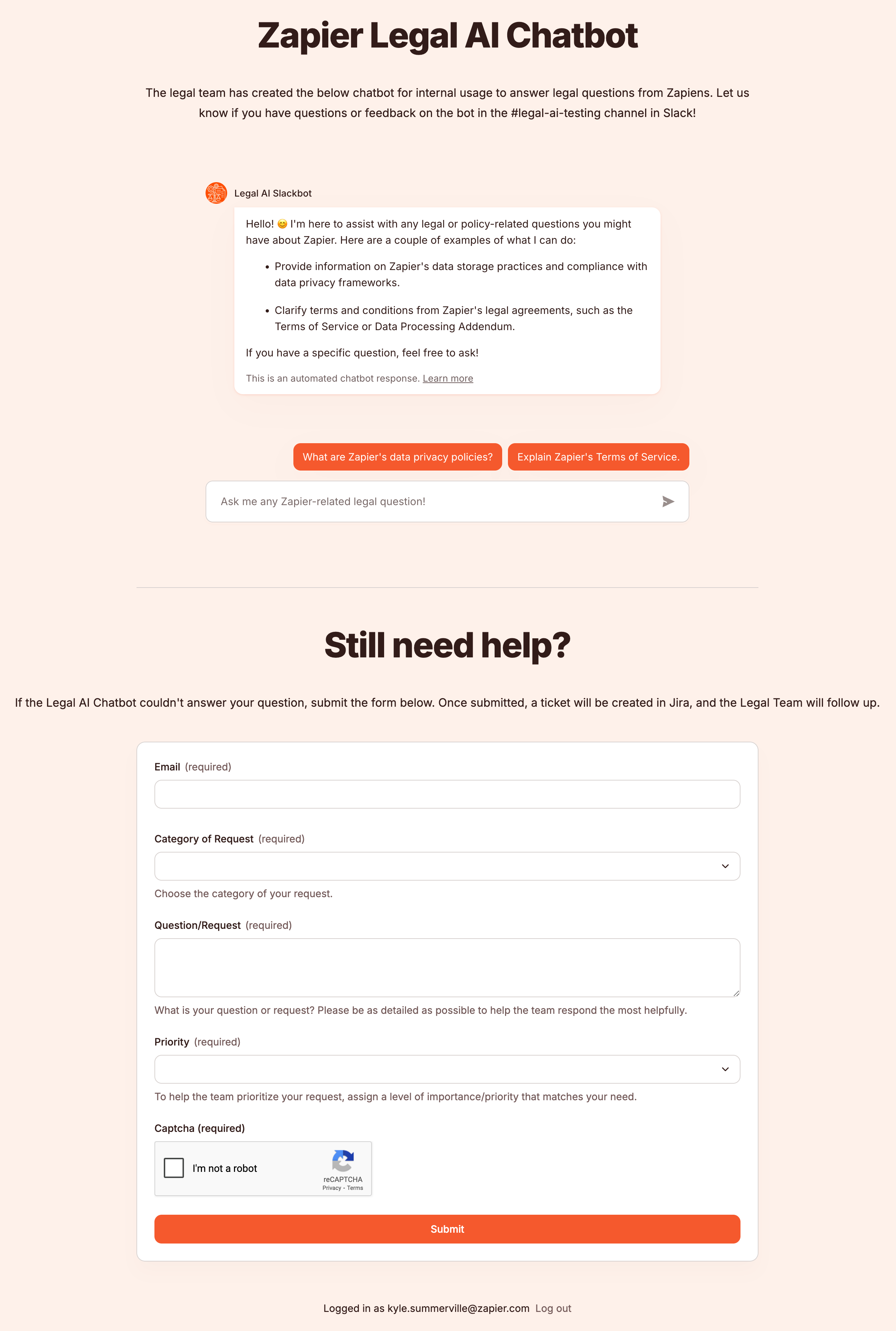
Step 5: Implement Intelligent Workflow Integrations
Enhance your automation system with smart integrations between tools:
- Connect your chatbot to collaboration platforms:
- Integrate with Slack or Microsoft Teams for immediate access
- Enable context-aware responses based on conversation history
- Support thread-based discussions for complex topics
- Zapier Workflows makes these extremely simple! See the images below for our example workflow and detailed explanations.
- Implement smart triggers and reactions:
- Create reaction-based escalation as shown in Image 4 (examples could include using a "checkmark" reaction to indicate the question has been answered, a "plus" reaction to request follow-up information, or a "Jira" or "Zendesk" reaction to kickoff a ticket for more complex requests - more below).
- Set up automatic ticket creation when the chatbot can't answer a question.
- Develop workflows for status tracking and updates.
- Enable self-service through automation:
- Allow users to trigger standard processes directly from chat
- Use Interfaces-based forms for collecting required information
- Provide an ability for users to mark a query as "completed" if the bot answers their question to their satisfaction, so that no further input is needed from the legal team.
Implementation tip: As illustrated in Images 5 and 6 below, create workflows that monitor for specific reactions to chatbot messages and trigger appropriate follow-up actions, such as form submission or ticket creation.
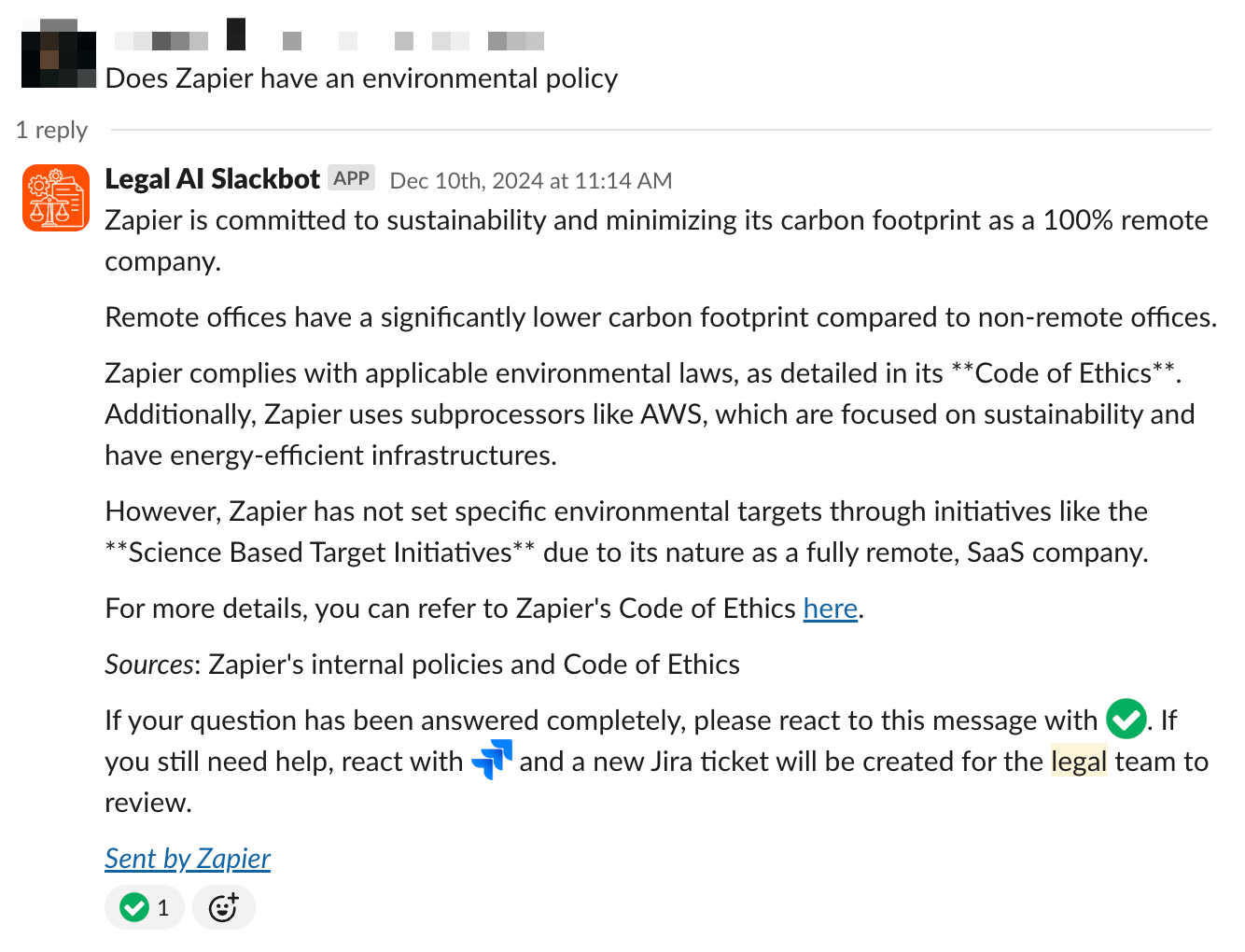


Step 6: Implement Role-Based Access and Security
Ensure appropriate access controls and security measures:
- Define access levels:
- Determine who should have access to different types of legal information
- Create role-based permissions for sensitive content and your knowledge base generally
- Implement proper authentication mechanisms
- Secure sensitive data:
- Ensure compliance with data protection regulations and your internal policies for any tools or systems you use
- Maintain audit logs of system access and usage if needed
- Address privacy concerns:
- Clearly communicate to users how their data will be used
- Implement data retention policies
- Provide opt-out mechanisms where appropriate
Implementation tip: Maintain a systematic approach to document management with appropriate access controls (example in Image 7) and regular review schedules. Keeping your access controls, and the information itself, up-to-date, is essential to protect your data and ensure accurate and complete responses from your chatbot.
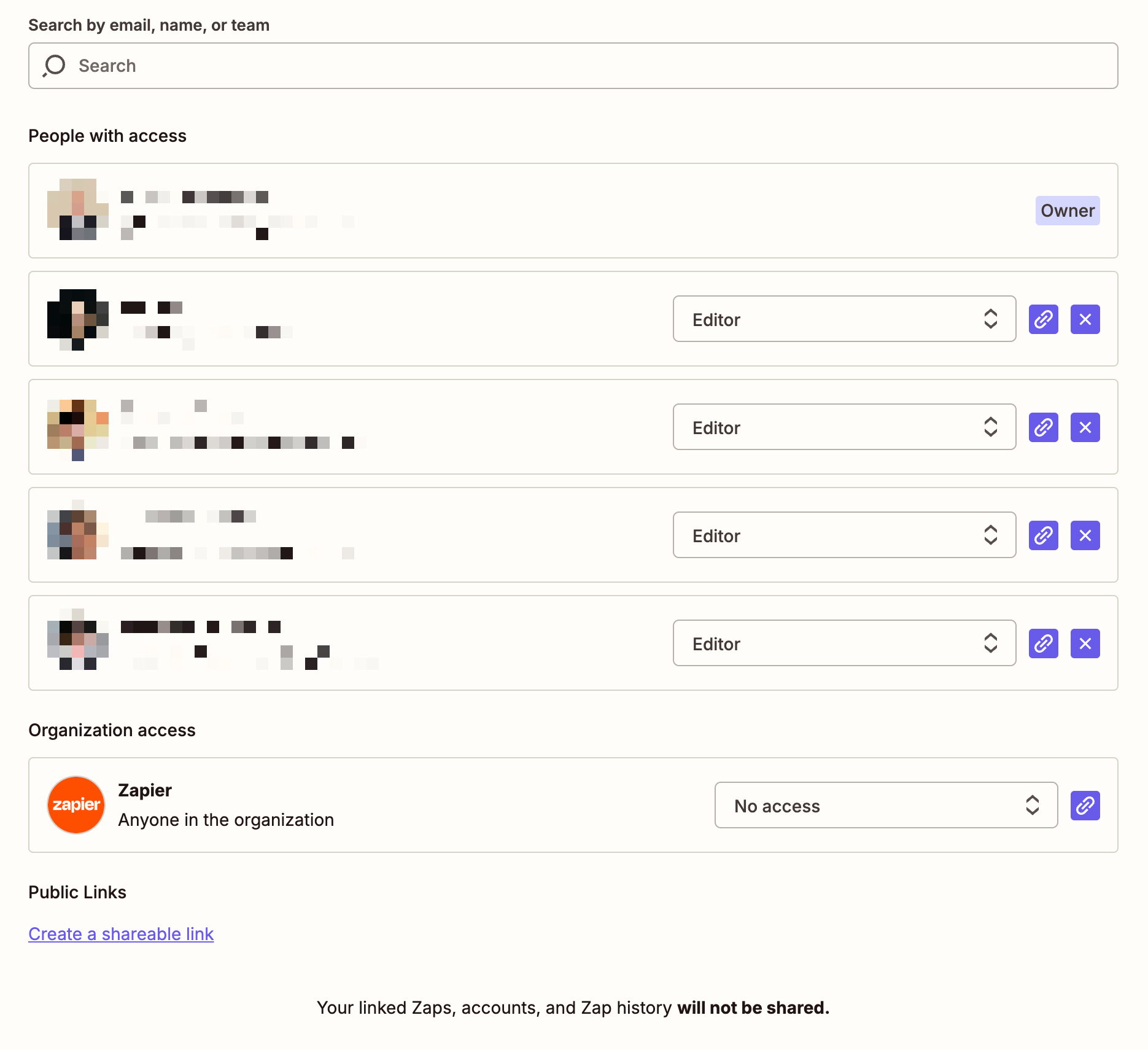
Step 7: Monitor, Measure, and Refine
Continuously improve your system through regular evaluation:
- Track key performance metrics:
- Response time to legal inquiries
- Accuracy of automated responses
- Volume of requests handled without human intervention
- User satisfaction ratings
- Collect and analyze feedback:
- Implement simple feedback mechanisms (like the checkmark/follow-up reactions discussed previously)
- Regularly review chatbot conversation logs to identify improvement areas
- Optionally, conduct periodic user surveys
- Iterate and improve:
- Regularly update your knowledge base with new information
- Refine your chatbot prompt and responses based on user interactions
- Expand automation to additional processes as appropriate
Implementation tip: Review chatbot transcripts as shown in Image 8 to identify patterns in questions and improve response accuracy over time. Zapier Chatbots also provides usage statistics and chat logs for a complete picture of your system's metrics and accuracy.
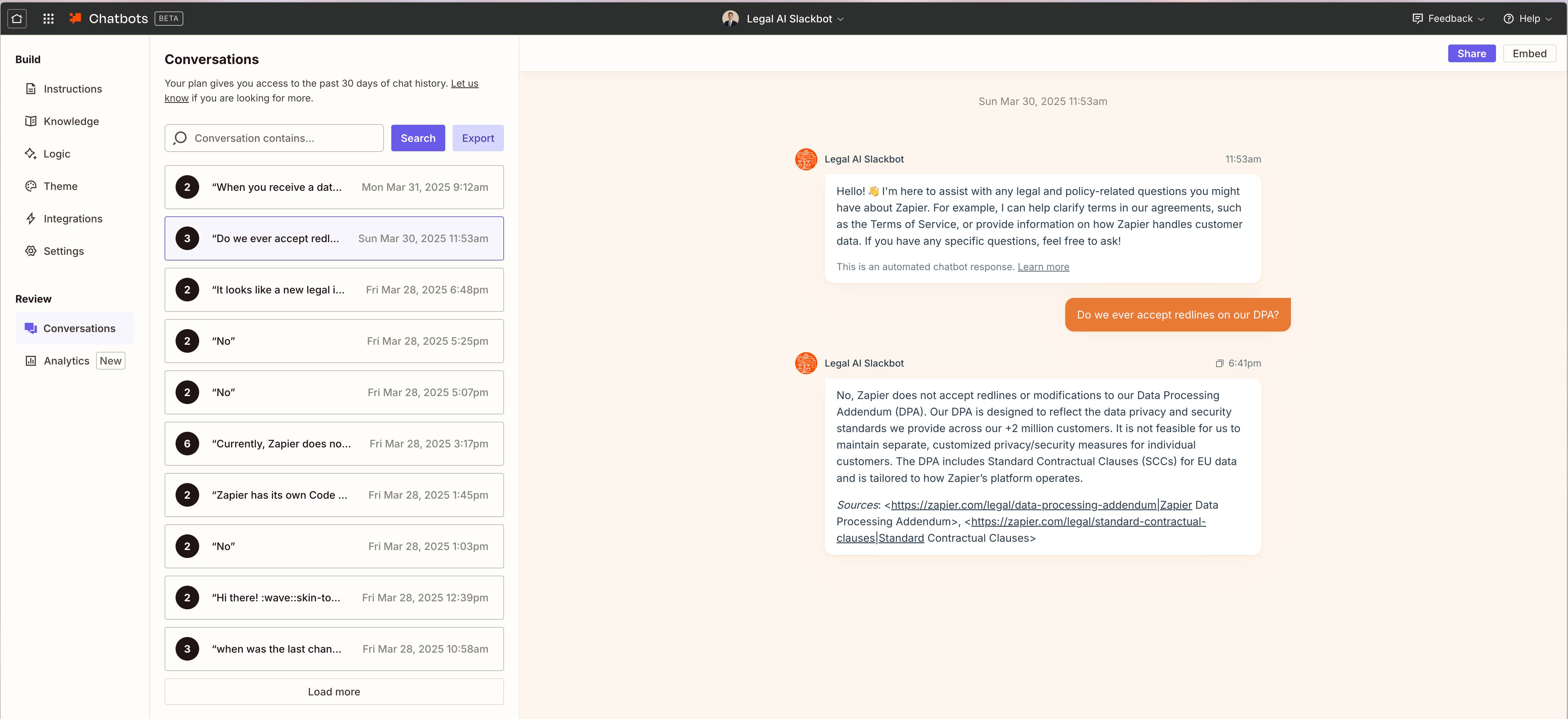
Conclusion
Leveraging AI and automation through tools like Zapier Workflows, Chatbots, Tables, and Interfaces is transformative for in-house legal teams, significantly enhancing capacity and responsiveness. By following these steps, legal departments can shift from repetitive, manual tasks to strategic, high-value work.
At Zapier, we've seen firsthand how automation can drastically reduce response times and elevate legal function effectiveness—proving these technologies are not just achievable and “nice to have”, but are essential for modern legal operations. Please reach out to our Sales team if you have any questions or would like to get started on your legal automation adventure!
Appendix: Quick Start Implementation Checklist
- Conduct an audit of repetitive tasks and inquiries
- Select and acquire necessary tools (or just use the tools you already have!) based on your specific needs
- Create a structured knowledge base with categorized FAQs
- Draft your chatbot's instruction prompt based on your use cases, contracts, and preferences
- Configure your chatbot with initial responses to most common questions
- Implement workflow integrations with collaboration and communication platforms
- Establish security controls and access management
- Train team members on system use and maintenance
- Set up feedback collection and performance tracking
- Schedule regular review and improvement sessions, as needed

